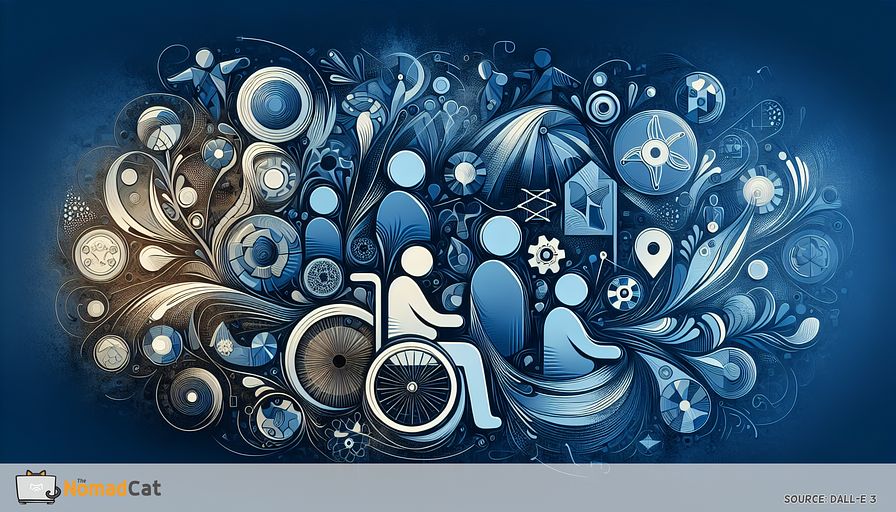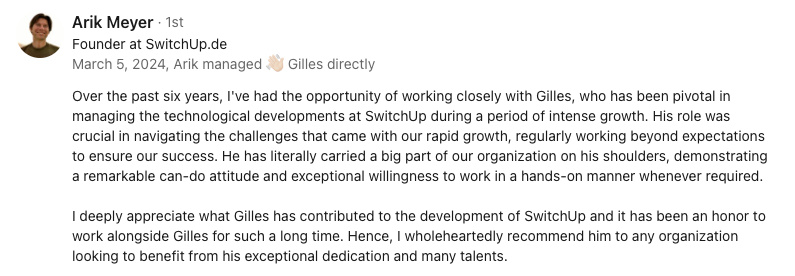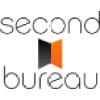Abstract:
This article explores how innovative assistive technologies are transforming the lives of individuals with disabilities, offering them greater independence and quality of life. From wearable devices that support mobility to software solutions enhancing communication and learning, the landscape of assistive tech is broad and continues to grow. Emphasis is placed on the role of inclusive design principles, ensuring that new technologies are accessible to all users from the outset. By highlighting key advancements and sharing stories of real-world impact, the piece aims to bring attention to the critical role of technologies designed with accessibility in mind. It also addresses the ongoing challenges in this field, including the need for widespread adoption and continued innovation to meet diverse needs. The goal is to showcase how embracing technology for social good can lead to a more inclusive society where everyone has the tools they need to thrive.
assistive technologies transforming lives
Assistive technologies are revolutionizing the lives of individuals with disabilities, providing newfound independence and significantly improving their quality of life. From wearable devices that enhance mobility to sophisticated software solutions that aid communication and learning, these technologies offer invaluable support to those in need. As we explore various assistive solutions, it’s critical to acknowledge the broader impact of these innovations on promoting inclusivity and accessibility in society. Through this lens, we can appreciate the remarkable contributions assistive technologies make in building a world where everyone has the opportunity to thrive.
wearable devices supporting mobility
Wearable technology has made tremendous strides, offering innovative solutions that enhance mobility for individuals with disabilities. I am particularly impressed by the advancements in smart prosthetics and exoskeletons, which have truly changed lives.
emerging technologies in mobility aids
Smart prosthetics leverage sensors and AI to emulate natural movement, allowing amputees to perform tasks that were once incredibly challenging. These devices can adapt to the user's walking pattern, providing a more personalized experience. For example, the Ottobock C-Leg has helped countless individuals regain their independence by allowing them to walk with confidence and stability.
On the other hand, exoskeletons have emerged as extraordinary tools for enhancing mobility, particularly for those with spinal cord injuries. These wearable structures support the body and facilitate walking through motorized joints. The ReWalk Robotics exoskeleton is a notable example, enabling users to stand, walk, and even climb stairs.
real-world impact of mobility wearables
The real-world implications of these devices cannot be overstated. I've had the privilege of meeting individuals who have regained the ability to walk or run, reconnecting with the world around them. The emotional and psychological benefits, alongside the physical improvements, highlight the importance of continued innovation in this field.
- Ottobock C-Leg: Empowers amputees to walk naturally.
- ReWalk Robotics: Allows individuals with spinal injuries to stand and move independently.
The progress in wearable mobility devices is both inspiring and essential. As we embrace these advancements, it's exciting to think about the future possibilities and how they will shape more autonomous and fulfilling lives for those in need.
software solutions enhancing communication and learning
Software applications are playing a pivotal role in breaking down barriers for individuals with disabilities, particularly in communication and education. I am continually amazed by how adaptive technologies, speech-to-text applications, and learning tools are transforming lives.
adaptive technologies in communication
Augmentative and Alternative Communication (AAC) devices are remarkable tools that help individuals with speech impairments communicate more effectively. These devices range from simple picture boards to advanced speech-generating devices. One such innovation is the Tobii Dynavox, which uses eye-tracking technology to allow users to form sentences and express themselves.
speech-to-text applications
Speech-to-text applications have seen significant advancements, offering real-time transcription that aids individuals with hearing impairments or learning disabilities. Applications like Dragon NaturallySpeaking and Google Live Transcribe enable users to convert spoken words into written text effortlessly, facilitating easier communication and access to information.
learning tools making a difference
In the educational sector, specialized software is opening new doors for students with disabilities. Assistive learning tools such as Kurzweil 3000 and Read&Write provide features like text-to-speech, word prediction, and study aids. These tools help students grasp complex subjects, stay organized, and participate more fully in educational activities.
- Tobii Dynavox: Enables communication through eye-tracking technology.
- Dragon NaturallySpeaking: Converts speech to text for improved accessibility.
- Kurzweil 3000: Offers text-to-speech and other assistive features for learning.
Seeing these innovative software solutions in action, I am optimistic about their potential to dramatically improve the lives of individuals with disabilities. These technologies not only support day-to-day activities but also contribute to long-term personal and educational growth.
inclusive design principles
Embracing inclusive design principles is essential in creating assistive technologies that truly serve everyone. By designing with accessibility in mind from the start, we don't just cater to individuals with disabilities; we enhance the experience for all users. This approach cultivates a landscape of innovation and inclusivity.
Inclusive design considers the diverse needs of users, ensuring that products are adaptable to various abilities and preferences. For example, creating user interfaces with customizable text sizes and voice command options benefits not just those with visual impairments, but also users in various environments.
The beauty of inclusive design lies in its universal application. Features such as closed captions and ergonomic controls, initially intended for users with specific requirements, often become favored by all. When these considerations are integrated from the beginning, it leads to more intuitive and user-friendly solutions.
- Customizable interfaces: Adjustable text sizes and voice commands.
- Universal features: Closed captions and ergonomic controls.
I firmly believe that adopting inclusive design principles not only demonstrates a commitment to accessibility but also drives forward-thinking innovation. The resulting products resonate with a broader audience, showcasing technology's potential to enhance everyday life for everyone.
real-world impact stories
The true power of assistive technologies shines through in the stories of those whose lives have been fundamentally changed by these innovations. It's incredibly inspiring to witness the direct impact these solutions have on real people.
regaining mobility
Take the story of James, a war veteran who lost his leg in combat. Through the use of a smart prosthetic like the Ottobock C-Leg, James found his way back to mobility. As he put it, "Being able to walk alongside my children again was the greatest gift. It's these moments that make life worth living."
enhanced communication
For Sarah, a young woman with severe speech impairments, the Tobii Dynavox opened new doors of communication. She shares, "For the first time, I could actively participate in conversations with my friends and family. It gave me a voice and a newfound sense of confidence."
academic achievements
Let's not forget about Alex, a bright student with dyslexia. Utilizing the Kurzweil 3000, Alex managed to excel academically. His mother remarked, "The assistive learning tools made studying less frustrating for Alex. He now reads with ease and enthusiasm, which was a breakthrough for our family."
- smart prosthetics: James' story of walking again.
- Tobii Dynavox: Sarah's journey towards effective communication.
- Kurzweil 3000: Alex's academic turnaround.
These personal accounts emphasize the profound human side of technological progress. Listening to these experiences is a powerful reminder of the importance of continually innovating in assistive technologies to foster independence and enrich lives.
current challenges in the field
Despite remarkable advancements, the field of assistive technology faces several ongoing challenges. Key among them is the need for widespread adoption. While these technologies hold immense promise, limited awareness and understanding often hinder their uptake. Educating the public and professionals about the benefits and use of these innovations is essential for broader acceptance.
Affordability is another pressing issue. Many assistive devices come with high price tags, making them inaccessible to those who need them most. Considering cost-effective solutions and advocating for insurance coverage can help bridge this gap. It's vital to ensure that financial barriers don't prevent individuals from accessing life-changing technology.
Accessibility gaps also pose a significant challenge. Not all environments are designed with inclusivity in mind, limiting the effectiveness of assistive tools. Promoting inclusive design and working towards a universally accessible infrastructure are steps in the right direction.
- Widespread adoption: Raising awareness and educating stakeholders.
- Affordability: Reducing costs and securing insurance coverage.
- Accessibility gaps: Enhancing inclusive design and infrastructure.
These challenges underscore the importance of continued innovation and collaboration. By addressing these hurdles, we can ensure that assistive technologies reach their full potential in improving lives and fostering independence.
future trends in assistive technology
I am particularly excited about the future of assistive technology, as ongoing research and emerging innovations hold great promise for further transforming lives. One area of significant growth is the integration of artificial intelligence (AI) and machine learning. These technologies are enhancing the capabilities of assistive devices, making them smarter and more adaptive to individual needs. For instance, AI-driven speech recognition systems are becoming more accurate and responsive, improving communication aids substantially.
virtual reality and augmented reality
Virtual Reality (VR) and Augmented Reality (AR) are also poised to play a pivotal role. These technologies offer immersive experiences that can aid in physical rehabilitation and cognitive therapy. Imagine using VR to simulate real-world scenarios for individuals learning to navigate environments safely and independently. This interactive approach can accelerate recovery and skill acquisition, providing a dynamic complement to traditional methods.
brain-computer interfaces
Another groundbreaking area is Brain-Computer Interfaces (BCIs). These interfaces enable direct communication between the brain and external devices, allowing individuals with severe disabilities to control computers, prosthetics, and other assistive tools using their thoughts. As BCI technology matures, it could revolutionize how we approach severe mobility and communication impairments.
- AI and machine learning: Enhancing adaptability and accuracy in assistive devices.
- VR and AR: Offering immersive environments for rehabilitation and skill-building.
- BCIs: Enabling mind-controlled assistive technology for greater independence.
With these promising advances, I believe the future of assistive technology is brighter than ever. The continued push for innovation will undoubtedly lead to more sophisticated, accessible, and affordable solutions, empowering individuals with disabilities to lead more autonomous and fulfilled lives.
the role of technology in building an inclusive society
Technology plays a pivotal role in fostering a more inclusive society, particularly through the advancement of assistive technologies. By embracing these innovations, we contribute significantly to social good and ensure everyone has the tools needed to thrive.
One of the most compelling aspects of tech-driven inclusivity is its power to break down barriers. Assistive devices and software provide individuals with disabilities the independence and opportunities to engage fully with their communities, workplaces, and educational environments. This not only improves individual quality of life but also enriches society as a whole by integrating diverse perspectives and talents.
Moreover, the widespread implementation of inclusive design principles in tech products and services showcases our commitment to creating environments where all users feel valued and accommodated. This shift fosters a culture of empathy and understanding, paving the way for broader societal acceptance and integration of people with diverse needs.
- Breaking down barriers: Supporting independence and engagement.
- Valuing diverse perspectives: Enriching communities and workplaces.
- Cultivating empathy: Promoting societal acceptance and integration.
In embracing these advancements, we build a society that is not only more inclusive but also more innovative and resilient. The collective benefits of technology-enhanced inclusivity reinforce the imperative to continue investing in and advocating for assistive tech solutions.
You might be interested by these articles:
- Enabling Tech for the Disabled
- Tech Innovations Aiding Disability
- Harnessing Europe's Diversity for Accessibility Innovation





